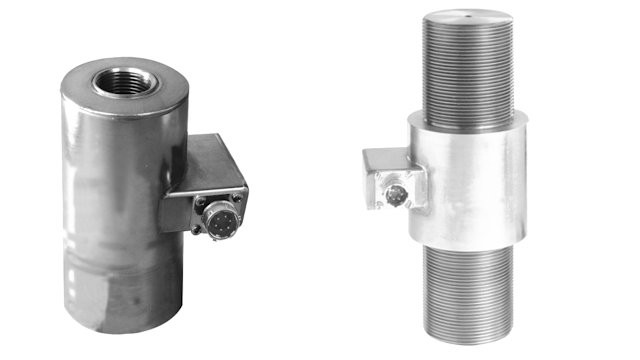Load cell
Load cell
A load cell is a transducer which converts force into a measurable electrical output. Although there are many varieties of force sensors, strain gauge load cells are the most commonly used type.
Introduction
Electrical output is in the order of a few millivolts and requires amplification by an instrumentation amplifier for further use
Load Cells are also called Load Transducer or Load Sensors
Force is measured in terms of deflection or strain of elastic member (strain gauge type), increase in fluid pressure (hydraulic type).
Types of load cells
- Hydraulic load cells
- Pneumatic load cells
- Strain gauge load cells
Hydraulic load cells
Hydraulic cells are force -balance devices, measuring weight as a change in pressure of the internal filling fluid. In a rolling diaphragm type hydraulic force sensors, a load or force acting on a loading head is transferred to a piston that in turn compresses a filling fluid confined within an elastomeric diaphragm chamber.
As force increases, the pressure of the hydraulic fluid rises. This pressure can be locally indicated or transmitted for remote indication or control. Output is linear and relatively unaffected by the amount of the filling fluid or by its temperature.
If the load cells have been properly installed and calibrated, accuracy can be within 0.25% full scale or better, acceptable for most process weighing applications. Because this sensor has no electric components, it is ideal for use in hazardous areas.
Pneumatic load cells
Pneumatic load cells also operate on the force-balance principle. These devices use multiple dampener chambers to provide higher accuracy than can a hydraulic device. In some designs, the first dampener chamber is used as a tare weight chamber.
Pneumatic load cells are often used to measure relatively small weights in industries where cleanliness and safety are of prime concern.
The advantages of this type of load cell include their being inherently explosion proof and insensitive to temperature variations. Additionally, they contain no fluids that might contaminate the process if the diaphragm ruptures. Disadvantages include relatively slow speed of response and the need for clean, dry, regulated air or nitrogen.
Strain gauge load cells
Strain gauge load cells are a type of load cell where a strain gauge assembly is positioned inside the load cell housing to convert the load acting on them into electrical signals. The weight on the load cell is measured by the voltage fluctuation caused in the strain gauge when it undergoes deformation.
The gauges themselves are bonded onto a beam or structural member that deforms when weight is applied. Modern load cells have 4 strain gauges installed within them to increase the measurement accuracy. Two of the gauges are usually in tension, and two in compression, and are wired with compensation adjustments.
When there is no load on the load cell, the resistances of each strain gauge will be the same. However, when under load, the resistance of the strain gauge varies, causing a change in output voltage. The change in output voltage is measured and converted into readable values using a digital meter.
Working Principle
A load cell is made by bonding strain gauges to an elastic material.
For accurate measurement, strain gauges are bonded to the position on the Elastic material where the impact of the stress will be the largest.
The strain gauge utilizes this principle and detects a strain by changes in electrical resistance.
Advantages
- Rugged and compact construction.
- No moving parts.
- Highly Accurate.
- Wide range of measurement, can be used for static and dynamic loading.
Disadvantages
- Mounting is difficult.
- Calibration is a tedious procedure.
How does a load cell work?
A load cell works by converting mechanical force into digital values that the user can read and record. The inner working of a load cell differs based on the load cell that you choose. There are hydraulic load cells, pneumatic load cells, and strain gauge load cells. Strain gauge load sensors are the most commonly used among the three. Strain gauge load cells contain strain gauges within them that send up voltage irregularities when under load. The degree of voltage change is covered to digital reading as weight.
When to use a load cell?
A load cell measures mechanical force, mainly the weight of objects. Today, almost all electronic weighing scales use load cells for the measurement of weight. They are widely used because of the accuracy with which they can measure the weight. Load cells find their application in a variety of fields that demand accuracy and precision. There are different classes to load cells, class A, class B, class C & Class D, and with each class, there is a change in both accuracy and capacity.
Applications
- Dual Tank Level Controller
- Bag Filling Machine
- Tank / Silo / Hopper
- Food Packaging

Comments
Post a Comment